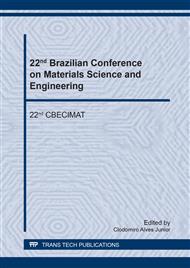p.190
p.195
p.201
p.207
p.212
p.218
p.224
p.230
p.236
Antimicrobial Activity of PET-Silver Nanocomposite Filaments
Abstract:
This study evaluated the antimicrobial activity of PET-Silver nanocomposite filaments at different concentrations (0, 0.180%, 0.135%, 0.090%, 0.045% and 0.022% w/w) of silver nanoparticles in order to determine the minimum inhibitory concentration and minimum bactericidal concentration of silver incorporated in the PET matrix. The in vitro antibacterial activity was evaluated by the AATCC standard 100: 2012 method, against Staphylococcus aureus ATCC 6538, and Klebsiella pneumonia ATCC 4532. The filaments were tested after one and twenty-one months of preparation to evaluate the effect of time on the antimicrobial activity of the nanocomposites. Moreover, the antimicrobial activity was also evaluated after dyeing the filaments. The silver-free PET filaments have not demonstrated antimicrobial activity and cytotoxicity against human dermal fibroblasts. Nevertheless, excepted for the filament with 0.022% of silver nanoparticles, all PET-Silver nanocomposites reduced more than 99% the colony-forming units (CFU) of Staphylococcus aureus and Klebsiella pneumonia after one and twenty-one months of preparation. This suggests that the MIC of silver nanoparticles incorporated in the PET matrix is lower than 220 ppm (w/w) and the MBC is between 0.022 and 0.045% (w/w). However, after the dyeing process, no antimicrobial activity was observed for any PET-Silver nanocomposite filaments. This may be attributed to the release of silver from the PET matrix during the dyeing process or to the reaction/inactivation of the silver ions by the salts used in this chemical treatment.
Info:
Periodical:
Pages:
212-217
Citation:
Online since:
September 2018
Keywords:
Price:
Сopyright:
© 2018 Trans Tech Publications Ltd. All Rights Reserved
Share:
Citation:


